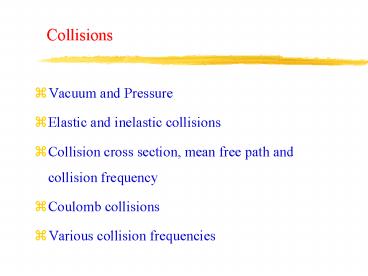Collisions - PowerPoint PPT Presentation
1 / 11
Title:
Collisions
Description:
mm Hg (millimeter of mercury from mercury manometers) ... with Boltzmann constant k, kT=300oK=300/11604 eV. n=p/kT=101325/(300*1. 602x10-19/11604)=2. ... – PowerPoint PPT presentation
Number of Views:48
Avg rating:3.0/5.0
Title: Collisions
1
Collisions
- Vacuum and Pressure
- Elastic and inelastic collisions
- Collision cross section, mean free path and
collision frequency - Coulomb collisions
- Various collision frequencies
2
Vacuum and Pressure
- Degree of vacuum indicated by pressure
- Units of pressure
- mm Hg (millimeter of mercury from mercury
manometers) - 1 atm(standard atmosphere at 0oC)760 mm Hg
- Torr, mTorr (International Standard) 1 atm760
Torr - Pa(pascal)N/m2 (International Standard)
- 1 atm1. 01325x105 Pa 1 Torr133. 32 Pa
- Meaning of pressure
- Pressure depends on temperature as well as number
density - Perfect gas law
- with Boltzmann constant k, kT300oK300/11604
eV - np/kT101325/(3001. 602x10-19/11604)2 .
447x1025 molecules(atoms)/m3 - 1mTorr --gt 2 . 447x1025 / 760000 3. 2x1019 /m3
3
Basic Concepts of Collisions
- Collisions of charged particles in a plasma
- collisions with neutral atoms and molecules
- dominant in partially ionized plasmas
- collisions with other charged particles (Coulomb
collisions) - dominant in high-temperature plasmas
- Elastic and inelastic collisions
- elastic collision the sum of kinetic energies
of the collision partners are conserved. - inelastic collision the sum of kinetic energies
are not conserved. ionization and excitation - super-elastic the sum of kinetic energies are
increased after collision. de-excitation
4
Fundamental Collision Parameters
Hard sphere collision
of particles colliding in dx
fraction of incident particles colliding in dx
Uncollided flux
- Collision parameters
- collision cross section ?(v)
- mean free path ?mfp 1/(nn?) ? 1/p
- collision frequency ? v/ ?mfp nnlt?vgt Knn ?
p - reaction rate K lt?vgt
5
Results of Collisions
- Plasma diffusion and other transport processes
- Transfer energy between particles
- Responsible for the electrical resistivity of the
plasma
Complexity of Collision Processes
- The concept of collision in a plasma is subtle
- Relative velocity dependency of collision
processes - Integrated effects of interactions between
particles of all velocities - Effective collision frequency depends on the
specific process
6
Binary Coulomb Interaction inside the Debye Sphere
Parallel momentum change
electron
v
Coulomb logarithm
7
Coulomb Collisions Large-angle scattering and
small-angle collisions
Effective collision cross-section
- Impact parameters for small angle Coulomb
scattering - minimum from Coulomb force balance
- maximum from Debye length
- ratio gives importance of small angle scattering
8
Coulomb Logarithm
for
with
for
, the quantum mechanical effect need to be
accounted for
For electrons, Te 10eV
For protons, Te 10keV
9
Coulomb Logarithm
10
Coulomb Logarithm for electron-ion collisions
11
Coulomb Logarithm with Quantum Mechanical Effect
Classically,
Quantum mechanically by considering Debye
shielding potential,
Using the Born approximation,
for
, small angle contributions with
are negligible, so
The actual quantum mechanical effect is to remove
the contributions at large impact parameters
between ?D and (?D/ ?qm )ro leaving































